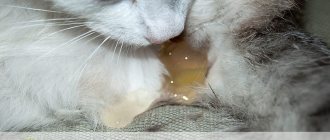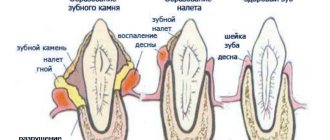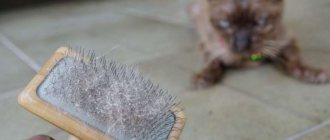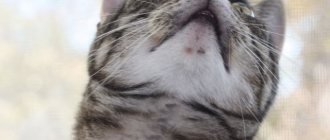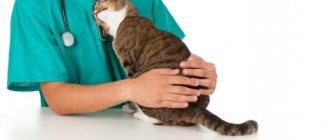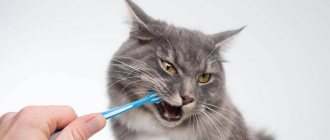Alena Igorevna Goncharenko
veterinarian Petstory
Skin diseases in cats are very common in veterinary practice. Such patients account for at least 30% of all types of visits to the clinic for help. To describe the condition of a pet's skin, owners usually use popular terms such as “sores,” “scabs,” “wounds,” and “ulcers.” In this article we will use the same terms for a better understanding and try to figure out why such problems arise and how to deal with them.
The main symptoms and manifestations of skin diseases in cats
Many skin diseases can present with very similar symptoms. You can often see bald patches, wounds, and scabs on the animal’s body. But some diseases have distinctive features, which, when seen, can make a preliminary diagnosis.
- Bald lesions on a cat's body can be found with lichen and demodicosis.
- A large number of scales similar to dandruff are observed when infected with the Cheyletiella mite.
- Wounds with crusts in the scalp area are noted with itching, which is often due to allergies.
- Skin ulcers on a cat's body can be found due to deep skin infection, thermal or chemical burns.
- Black spots on the chin are a sign of feline acne.
- Small crusts on a cat’s skin may indicate miliary dermatitis, which is how the cat’s body reacts to an infection or allergen.
- Pimples with white contents can occur with autoimmune diseases or superficial bacterial infections.
Scabies
The causative agents of scabies are microscopic mites that live on the surface of the skin and feed on blood and lymph.
Symptoms:
- Severe itching.
— Small papules can be found on the surface of the skin, most often localized near the ears, on the chest, abdomen, and joints.
— Focal hair loss, formation of ulcers. As a result of scratching, secondary bacterial infections occur.
Treatment:
1. Isolate the pet from household members.
2. Treat cat accessories.
3. Treat the affected areas with special ointments.
4. Give injections prescribed by your veterinarian.
5. Monitor the animal’s hygiene and do not take it out for walks until the end of treatment.
6. Provide your pet with a nutritious diet containing a sufficient amount of vitamins.
7. Carry out wet cleaning of the premises daily.
The therapy includes:
— Lime sulfur (LymDip) , a solution of which is applied once a week. A total of 6 procedures are performed. To improve contact of the medicine with the skin, the hair at the treatment site is cut. Before treating with sulfur, it is recommended to wash the cat with keratolytic shampoo.
— Ivermectin (Ivomec) is a drug that effectively relieves itching within the next 5 days after treatment. This unpleasant symptom disappears completely after a month.
— Amitraz (Mitaban) . Apply no more than 4 times every 2 weeks. Due to possible side effects, it is not recommended for use on dwarf cats, sick and elderly animals. — — Selamectin (REVOLUTION) is an avermectin drug that can be rapidly absorbed. It is completely safe, so it can be used to treat scabies in particularly sensitive animals. A single use is enough to destroy the infestation. Repeated treatment is carried out only in severe cases.
To treat mange, veterinarians often prescribe a drug called Stop Itch . It is available in the form of a suspension that has the ability to normalize the function of the skin without causing allergies. The drug is injected into the cat's mouth using a syringe without a needle.
============================================================================================================================================================================================
Common diseases that cause skin lesions
Lichen
Ringworm is a fungus whose spores infect a cat's fur. Usually, infection occurs from another sick animal, and spores can also be brought on clothes and shoes from the street, even if the cat is completely domestic. Ringworm in a cat most often looks like rounded bald patches with scales, crusts and scabs. Localization may be different, depending on which part of the body the fungal spores began to multiply. Ringworm in cats is often found on the face, especially around the nose, ears and around the eyes. You may notice hair loss and characteristic peeling of the skin. The cat most likely will not experience itching or other unpleasant sensations.
Allergy
There are three types of allergies in cats: flea allergy dermatitis, food allergies and non-food allergies. Allergy itself is most often a hereditary disease, and signs in a sick animal appear when any of the allergens enter the body. In most cases they are all visually similar. The first sign of an allergy is itching. With intense itching, the cat will lick itself vigorously, especially in the abdominal area. Can scratch the area around the ears, neck, and chin with its paws. But cats are very secretive animals and will hide their illness from their owner until the last moment. Often signs of itching are detected only during administration. Usually, during the examination, the doctor finds characteristic wounds from the cat’s claws, as well as, as if trimmed, hair in the abdomen and groin area. A cat's tongue is very rough, with many papillae, and by licking itself intensively, the cat literally shave off its own fur.
Also typical of allergies can be lesions called miliary dermatitis. Most often, owners find small crusts on the cat's neck. Similar sores in a cat can appear on the withers, face and other places. Thus, the cat’s skin reacts to the influence of some external factor, in this case an allergen. Another characteristic form of allergy in cats is eosinophilic granuloma complex. This complex manifests itself in three main forms: eosinophilic granuloma, indolent ulcer and eosinophilic plaques.
- Eosinophilic granuloma in cats most often occurs on the chin or border of the lower lip. It looks like a pink or yellowish swelling, soft to the touch, and does not cause obvious discomfort to the cat.
- An indolent ulcer usually affects a cat's upper lip, although it can appear on other areas of the body. It appears as a lesion on the outer edge of the upper lip on one or both sides of the nose. The lesion initially resembles sores with crusts, which grow over time, become clearly defined, and have a red or brown surface. Their surface is concave in the center and raised at the edges.
- Eosinophilic plaques can be found on your cat's abdomen and inner thighs. They are oval or elongated in shape. The color is usually pink, the surface is raised. At first, such lesions are very small, but without treatment they merge and affect large surfaces of the cat’s body.
Scabies mites
There are three main types of skin mites found in cats: demodicosis, notoedrosis and cheyletieliosis. All three types of ticks have their own characteristic clinical signs.
Demodicosis in cats is very rare. The Demodex cati mite is not contagious. Normally, even healthy animals have it. The tick begins to multiply and cause clinical manifestations against the background of the pet’s reduced immunity. It will look like a hairless patch of skin on any part of the cat's body. Most often, such a lesion does not cause concern in the cat. There may be crusts, scales, pimples on the skin, but they may be completely absent. Another type of demodicosis - Demodex gatoi, on the contrary, is very contagious. Cats with this infection experience severe itching and scratch themselves until they bleed.
Hurry up, choose a box and find out what gift awaits you
Discount on pet insurance
Promo code copied to clipboard
Notoedrosis is also a contagious disease, transmitted from a sick cat to a healthy one. Ticks live in the environment for a short time and die quite quickly. Areas affected by mites will look like thickened skin with a lot of crusts and scabs. Scabs on the skin of a cat with notoedrosis can appear all over the body, but more often on the neck, head, chin, and ears. The cat will most likely scratch these areas intensively with its paws. Wool also falls out in these areas. Cheyletieliosis is transmitted between cats, dogs, and rabbits, and is similar in appearance to manifestations of seborrhea sicca. Owners may notice that the cat's skin is very flaky. Usually these peelings are very pronounced, flaky scales that remain throughout the apartment where the cat was. Only a small area of the body may be affected, but most of the skin may be affected.
Acne
Feline acne is not actually a disease. Often it is just a sign that your pet has an allergy. But sometimes it is not possible to establish its cause. Typically, the reason for contacting the clinic is when the owner discovers sores on the cat’s chin. At the beginning of the disease, only small black dots – comedones – can be seen on the chin. Comedones are pores clogged with dirt, sebum and pieces of epithelium. Without treatment, their number increases. Then large red or white-headed pimples and boils appear on the chin.
Autoimmune diseases
There are many different autoimmune skin diseases in cats. The exact cause of their occurrence in pets could not be established, but it is assumed that chronic inflammation and a reaction to medications may be the cause. With such a disease, the skin's own immune cells begin to attack skin cells, which manifests itself in the form of lesions on the body. The most common autoimmune conditions include pemphigus foliaceus. It is characterized by the presence of small pustules on the skin - pimples with a white head. It is quite rare to find such small sores under a cat’s fur. Most often, lesions become noticeable in later stages. You can note the appearance of crusts, scales, and bald patches. Lesions in the area of the ears and nose are typical, and often the only symptom is thickening and crusting on the pads of the cat's paws. Crusts around the claws are also observed in many cases.
Psychogenic itching
Oddly enough, in the presence of stress factors, cats can also intensively lick, scratch or chew themselves. Often with this condition, a cat may have a wound on its tail. The pet inflicts it on himself with his teeth and claws. Stressful factors for cats can be noisy work in the house or with neighbors, rearranging furniture, prolonged absence of owners, and even changing litter for the tray or food.
Non-parasitic
Non-parasitic diseases include skin lesions such as acne, eczema and bedsores. The difference between non-parasitic infections and parasitic ones is that they are not transmitted to humans or other animals and arise solely as a result of exposure to external irritants.
Acne
This is a bacterial inflammation of the sebaceous glands. The reason for this is a weak immune response. The main symptom is purulent pimples or blackheads located throughout the animal’s body. Treatment consists of using tar soap or anti-dandruff shampoo, and then treating the affected areas with antiseptics such as Miramistin. Sometimes the use of local antibiotics (Mupirocin) is required.
Eczema
It most often occurs in cats with very sensitive skin. The reasons are various injuries and damage to the skin, hormonal imbalances.
Typical symptoms include:
- rash;
- severe itching;
- irritation;
- blisters on the body;
- increased body temperature.
Over time, the wounds begin to peel off and then turn into weeping, purulent wounds.
Treatment consists of using soothing ointments, creams, gels and powders (Vishnevsky ointment, zinc ointment, Lassar ointment). Antiseptics should be used before applying the ointment. In advanced cases, the use of antibiotics may be required.
Bedsores
Appear after a long period of lying and immobility of the animal. Often affects pets in the postoperative period or paralyzed cats. It appears in those places that are in direct contact with the surface. It is important to follow preventive measures (lubricate parts of the body touching the surface with camphor alcohol). Levomekol ointment is used for treatment.
Diagnostics
A preliminary diagnosis can only be made based on the results of the examination, since the diseases have characteristic clinical signs described above. Additional studies are required to confirm the diagnosis. To exclude the presence of a bacterial or fungal infection, a cytological examination of skin smears is performed. Also, thanks to it, you can see the cells that appear in autoimmune diseases. Autoimmune disease is confirmed using skin histology. Using scrapings, in most cases it is possible to detect skin mites, but the Demodex gatoi mite is very rarely found in scrapings, and this disease is not easy to diagnose. Several methods can be used to diagnose lichen. First, the animal is examined under a fluorescent lamp - this method makes it possible to detect lichen in 50% of cases, since not all types of this infection will glow under the lamp. Then trichoscopy can be performed, thanks to which you can see the hairs destroyed by fungal spores. A more accurate diagnosis is to inoculate hairs in special growth media. Fungi in such environments can grow for a long time, up to 3-4 weeks, but the accuracy of this diagnosis is at least 95%.
Most often, identifying an allergen is not an easy task; there are no special tests for this. First, using scrapings, cultures, etc., it is necessary to exclude all possible differential diagnoses, which will be suggested by the doctor. If allergy remains the most likely diagnosis, the stage of excluding possible allergens will begin. First of all, fleas are excluded, the animal and the room where it lives are treated. A special elimination diet may then be prescribed to rule out food allergies. If the allergen is not identified, a diagnosis of “non-food allergy” or “atopy” is made.
Food allergies
Symptoms:
- Skin reaction. Itching manifests itself mainly on the face and head, ears, neck, paws and stomach.
- Hair loss. It occurs as a result of itching: the cat begins to itch, and this causes bald spots to appear on its fur - bare areas of skin.
- Wounds and ulcers. This is the next stage after the formation of bald spots, which occurs if the allergy is not treated: the animal will continue to itch. First, redness and irritation appear, in place of which painful wounds can form.
- Stomach upset. If the allergen is present for a long time in the cat’s diet, it begins to feel sick and loose stools appear.
- Edema. In the later stages of allergy development, the cat swells and has difficulty breathing.
Treatment:
1. Selection of hypoallergenic food.
2. To remove allergic reactions such as itching, drugs that have analgesic, antihistamine, decongestant and anti-inflammatory effects are used.
============================================================================================================================================================================================
Treatment of skin diseases in cats
If bacterial or fungal flora is detected in the affected areas of the body, local and systemic drugs, various antibiotics and antifungal agents are prescribed. If the cat is good at washing, bathing with antibacterial shampoos is convenient. Skin mites are treated with antiparasitic drugs. Recently, modern preparations in the form of drops on the withers have been used for this; they are highly effective. Autoimmune diseases are treated with drugs that suppress the immune system - immunosuppressants. Such drugs can be prescribed either as a course or on an ongoing basis. To treat allergies, it is necessary to identify the allergen and eliminate it from the animal’s life. But this is not always possible. Otherwise, drugs against itching and inflammation are used. If your pet's allergies are seasonal, then the tablets should be taken only during the period of exacerbation. If the allergy is constant year-round, then the drugs will have to be used for life, trying to choose the minimum effective dosage. To treat psychogenic itching, sedatives and antidepressants are used.
Eosinophilic granuloma
Eosinophilic granuloma is an inflammatory disease of the oral mucosa and skin. As a rule, it occurs due to insect bites - fleas, mosquitoes or an allergic reaction to food components.
Symptoms:
- Single swollen areas in the oral cavity.
- Redness and swelling of the skin.
- Baldness at the site of redness.
- There is no pain or itching.
— Local lymph nodes swell.
- If lesions have developed in the mouth, the animal cannot eat and drink normally, and therefore signs of exhaustion and dehydration quickly increase.
Treatment:
Granuloma can only be cured with hormones, since there are no other means for this.
1. A course of antibiotic therapy.
2. Antihistamines, which can help in almost all cases, as they effectively relieve itching. This treatment is available at home, but you should still consult your veterinarian first.
3. Immunosuppressants such as cyclosporine or chlorambucil. They are useful if granuloma has developed against the background of autoimmune diseases.
4. Prescription of hydrocortisone. This drug also belongs to the hormonal category, but its use does not cause dangerous side effects.
============================================================================================================================================================================================
Prevention
The main methods of preventing skin diseases in cats include regular antiparasitic treatments. Using drops on the withers, even for domestic cats, allows you to avoid many unpleasant situations associated with infestation with fleas and ticks. The contact of a domestic cat with stray animals should be limited. It is necessary to organize the pet’s living environment in such a way that it does not need anything and does not experience chronic stress. Stress can lead not only to psychogenic itching, but also to a decrease in the overall immunity of the body.
Atopic dermatitis
One of the types of allergies that is caused by irritating external factors: pollen, dust, synthetic detergents.
Symptoms:
- Baldness.
-Pustules on the skin.
- Itching.
Treatment:
1. The doctor can prescribe broad-spectrum antimicrobial drugs in combination with antihistamines (Chlorpheniramine, Clemastil).
2. Non-steroidal anti-inflammatory drugs are prescribed.
3. If the animal’s condition is alarming, immunosuppressants are prescribed to suppress the “independent activity” of the immune system. Cyclosporine has proven itself well.
============================================================================================================================================================================================
Can a person get infected from a cat?
Most skin diseases in cats are not transmissible to humans and are only contagious between felines. Ringworm is potentially contagious to humans, and children, the elderly and people with weakened immune systems are considered especially vulnerable. Adults most often do not become infected from cats. If you notice signs of lichen, you should immediately consult a dermatologist. Notoedrosis can cause pseudoscabies in humans, but the disease itself does not require treatment.
Cheyletiosis
“Wandering dandruff” or cheyletiosis is caused by mites of the genus Cheyletiella. Animals develop dandruff along the spine line.
Symptoms:
- Severe itching.
- Minor hair loss, flakes, dandruff.
Treatment:
1. Injectable drugs: Pyrethrin, Fipronil.
2. Additionally, animal hair is treated with antiseborrheic shampoos. Long-haired cats need to have their fur trimmed first.
============================================================================================================================================================================================
First aid
The owner must provide the pet suffering from dermatitis with the most comfortable conditions and strictly follow all the veterinarian’s recommendations. Self-medication will cause irreparable harm to health, because the allergen that provoked the disease may well be hidden in the home medicine cabinet. Under no circumstances should you independently select or change medications prescribed by a veterinarian, or reduce or increase the dosage!
As first aid, you can give your four-legged pet the “Stop Itching” suspension to weaken the effect of the irritant. You should not smear the affected areas of the skin with anything, as this will significantly complicate the diagnosis in a veterinary clinic.
To prevent your cat from picking at sores, lightly file his claws and put on a light blanket to prevent infection from entering the wounds.
Swelling of the paws indicates that the dermatitis is most likely caused by an allergy to cat litter. In this case, you need to replace the contents of the tray, choosing a composition without small particles and odorless.
Recommendations for nutrition during the recovery period
Cat nutrition during a difficult period of recovery and rehabilitation should have an integrated approach. It must be remembered that a cat is a predator by origin.
Complete dry and wet food should correspond to the natural needs of the cat, its characteristics and history, take into account its dermatological problems and laboratory tests, depending on the specific case. The diet should be high in protein and contain polyunsaturated fatty acids omega-3 and omega-6, found in fish, which enhance the protective functions of the skin and accelerate healing.
The special needs of pets with skin and coat problems are taken into account in Purina® PRO PLAN® NUTRISAVOUR® Derma Plus complete wet food and PRO PLAN® Elegant Adult dry complete food for adult cats. The diets support healthy skin and a beautiful coat thanks to the content of high-quality protein, vitamin E and omega-6 fatty acids, zinc. In addition, they reduce excessive hair loss, support healthy digestion by controlling the formation of hairballs, and help hair move smoothly through the digestive tract.
During the recovery period, the cat needs special care and attention. It is important to maintain the indoor microclimate, sufficient air humidity and lighting, the cat’s activity and its psychological state.
Getting rid of dermatological problems should be approached comprehensively from different angles, and then the result will not keep you waiting!
Causes
Skin pathologies can bother cats temporarily, for example, arising when changing food and spontaneously stopping when returning to a normal diet. But much more often, pets are worried about seasonal diseases associated with increased activity of skin parasites. The most common causes of skin diseases are:
- ectoparasites - fleas, ticks lead to the occurrence of dermatitis, sarcoptic mange, notoedrosis, otodectosis;
- fungal infections cause lichen;
- improper care can cause an allergic reaction, acne, eczema;
- abnormalities in the development of sebaceous glands and hair follicles also cause acne;
- allergies, stress, injuries, kidney diseases, tumors, diabetes mellitus lead to bacterial infections of the skin;
- psychological disorders can cause baldness (alopecia);
- diseases of the internal organs (stomach, liver, kidneys) provoke eczema.

